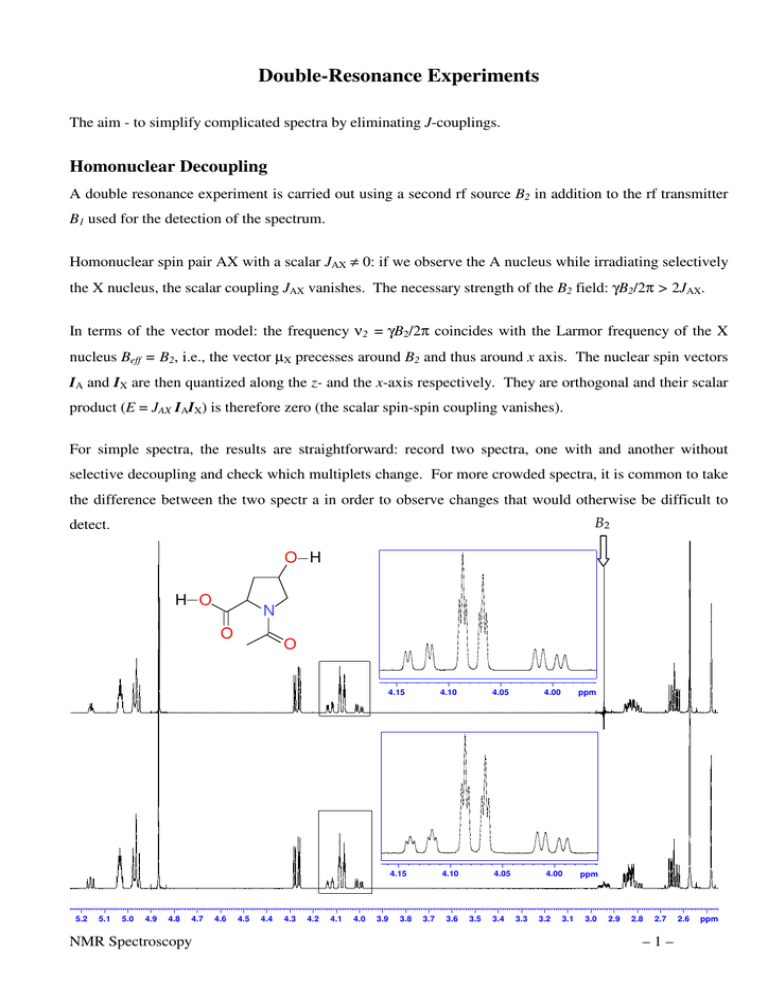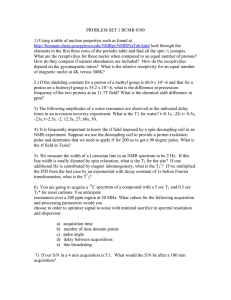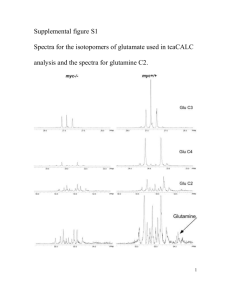NMR Spectroscopy: Double-Resonance Experiments & Decoupling
advertisement

Double-Resonance Experiments
The aim - to simplify complicated spectra by eliminating J-couplings.
Homonuclear Decoupling
A double resonance experiment is carried out using a second rf source B2 in addition to the rf transmitter
B1 used for the detection of the spectrum.
Homonuclear spin pair AX with a scalar JAX ≠ 0: if we observe the A nucleus while irradiating selectively
the X nucleus, the scalar coupling JAX vanishes. The necessary strength of the B2 field: γB2/2π > 2JAX.
In terms of the vector model: the frequency ν2 = γB2/2π coincides with the Larmor frequency of the X
nucleus Beff = B2, i.e., the vector µX precesses around B2 and thus around x axis. The nuclear spin vectors
IA and IX are then quantized along the z- and the x-axis respectively. They are orthogonal and their scalar
product (E = JAX IAIX) is therefore zero (the scalar spin-spin coupling vanishes).
For simple spectra, the results are straightforward: record two spectra, one with and another without
selective decoupling and check which multiplets change. For more crowded spectra, it is common to take
the difference between the two spectr a in order to observe changes that would otherwise be difficult to
B2
detect.
O H
H O
N
O
5.2
5.1
5.0
4.9
4.8
4.7
NMR Spectroscopy
4.6
O
4.5
4.4
4.3
4.2
4.1
4.0
4.15
4.10
4.05
4.00
ppm
4.15
4.10
4.05
4.00
ppm
3.9
3.8
3.7
3.6
3.5
3.4
3.3
3.2
3.1
3.0
2.9
2.8
2.7
–1–
2.6
ppm
Main problems:
(i) suffers from difficulties associated with selective irradiatiation of only those spins which are desired;
(ii) Bloch-Siegert shift: ν A'
γ B22
≈ νA +
8π 2 (ν A − ν X )
If several spin-decoupling experiments are desired, it is generally more time-efficient to perform a twodimensional COSY experiment in order to establish connectivities.
Heteronuclear Decoupling
The frequency difference ν2 - ν1 lies in the MHz range. The second field B2 is
1H{14N}
NMR
NH4+
produced by a separate transmitter.
A curly bracket is used to indicate which nucleus is being decoupled during the
experiment, e.g. 13C{1H} indicates a 13C spectrum acquired with 1H decoupling.
Can be used for simplifying spectra complicated by heteronuclear J-couplings (e.g.,
JHF or JHP) or for removing line broadening caused by quadrupolar nuclei (e.g., 14N).
1H
NMR
NH4+
Broadband decoupling
Broadband decoupling is used in order to eliminate the coupling between two nuclei completely. For
example, broadband 1H decoupling while acquiring
13
C spectrum leads to singlets for each
13
C
environment and a substantial increase in the sensitivity of the experiment.
Previously broadband decoupling techniques were based on the combined use of high-power decoupling
and frequency modulation of the B2 frequency with a randomly varying waveform (proton “noise”
decoupling). Generally, this results in an inefficient broadband decoupling and leads to loss of both
sensitivity and resolution.
Broadband decoupling techniques based upon the spin flip experiment (MLEV, Malcolm Levitt):
1
H
13
C
π __ τ __ π __ τ __ π __ τ __ π __ τ __ π __ τ __ . . .
π/2 Acquire . . .
NMR Spectroscopy
–2–
180° (1H)
-J/2
+J/2
-J/2
+J/2
On
Off
ADC
τ
2τ
A train of π pulses will be susceptible to the errors due to pulse length inaccuracy, since they will
accumulate. The non-ideal π pulse can be replaced with a composite pulse.
Composite πy pulse:
π
π
π y
2 x 2 x
Examples of composite pulse decoupling techniques:
WALTZ-16 and GARP
The linewidth achievable in WALTZ-16 13C NMR spectra is ~0.1 - 0.3 Hz (suitable for detecting small
effects such as 35/37Cl isotope effects of a few ppb).
----
____
conventional modulation technique;
-10
-8
-6
-4
-2
0
+2
kHz
+4
+6
composite pulse decoupling
+8 +10
Broadband decoupling of nuclei with large chemical shift ranges (19F, 31P) with 1H observation becomes
much more feasible on using such decoupling techniques as GARP.
The effective decoupling bandwidth: WALTZ-16
GARP-1
2B2 (B2 ≈ 5 kHz)
5B2 (slightly greater residual broadening of the lines)
Gated decoupling
Disadvantages of 13C{1H} spectra: (i) the nuclear Overhauser effect (NOE) leads to intensity distortions
and the integration of these spectra becomes questionable; (ii) the elimination of line splittings prevents
the measurement of 13C,1H coupling constants.
NMR Spectroscopy
–3–
The application of a method known as gated decoupling experiment successfully handles spin-spin
coupling and intensity distortions. In the first case, the decoupler is switched on during acquisition, but
switched off during the remaining time before the next pulse. The
13
C-1H coupling is thus eliminated
without producing NOE, as the integrals depend mainly on the intensities of the initial points of the time
domain function.
Pulse
Pulse
B1
NOE
∆
∆
∆
B2
Alternatively, relaxation reagents (e.g., chromium acetylacetonate) can be used to eliminate unwanted
NOEs. Because of their paramagnetic moment, relaxation reagents provide an efficient mechanism for
13
C spin-lattice relaxation that suppresses dipolar relaxation, which is the main phenomenon leading to
NOEs.
In the second case, the decoupler is gated: it is on during the delay time between different pulses and
switched off during acquisition.
Pulse
Pulse
FID
FID
B1
NOE
∆
∆
∆
B2
As a result, the spectra are not decoupled and most of the NOE is preserved. This provides higher
sensitivity for measurements of J(13C,1H) couplings.
NMR Spectroscopy
–4–
Example of signal multiplicities in a proton-coupled 13C NMR spectrum
13
C,1H coupling constants in pyridine
2J(H4)
2 Hz
3J(H5) 6 Hz
2J(H2) 7 Hz
1J(H3) 166 Hz
C-3
H
C-3
124.2 ppm
H
4
5
3
H
3J(H2)
4 Hz
1J(H4) 163 Hz
C-4
H
C-4
6
N
2
1
136.2 ppm
2J(H3)
2 Hz
3J(H4) 7 Hz
3J(H6) 12 Hz
C-2
1J(H2)
C-2
NMR Spectroscopy
177 Hz
149.7 ppm
–5–
H
Polarization Transfer
The aim - to increase sensitivity by transferring favourable NMR properties of the proton to another
nucleus.
Nβ / Nα = exp (-∆E / kT) ≈ 1 - ∆E / kT = 1 - γ h B0 / kT
∆n = Nα − Nβ
∆n ∝ γ h B0 / kT
Selective population inversion
A two-spin system 1H-13C (e.g., in CHCl3)
∆h−∆c
C2
−∆h+∆c
H1 {INVERTED}
-∆h-∆c
H2
C2
−∆h−∆c
-∆h+∆c
C1
H1
∆h+∆c
H2
∆h-∆c
C1
∆h+∆c
1H
1H
13C
13C
γH ≈ 4 γC
∆h ≈ 4∆c
13
C
−3 : +5
+1 : +1
Relative intensities for the X multiplet of an AXn group:
at Boltzmann distribution
after selective population inversion
n
1
1
1
1
1
1
2
3
4
0
1
1
3
6
NMR Spectroscopy
1
2
1
4
-3
-7
3
1
4
-11
-15
5
2
-9
-28
9
15
6
13
36
17
–6–
INEPT (Insensitive Nuclei Enhanced by Polarization Transfer)
1
π
π
− τ − πx − τ −
2 x
2 y
H:
13
πx
C:
π
2 x
Acquire
τ = 1 / (4 1JCH)
Non-selective pulses are used to put pairs of proton transitions into antiphase.
1H
90°x
180°x
1/(4J)
1/(4J)
90°y
The proton magnrtisation vectors are prepared in antiphase: the α vector along +z and the β vector along
-z (as in SPI). This corresponds to inverted 1H spin populations with the excess population in the upper
level. A 1H→13C polarization transfer occurs and a fourfold (γH/γC) enhancement in 13C signal-to-noise
ratio is achieved. As relaxation times T1(1H) are shorter than T1(13C), there is a further gain in the rate at
which signals can be accumulated.
DEPT (Distortionless Enhancement by Polarization Transfer)
1
H:
13
1
1
1
π
−
−πx −
− θ ±y −
− ( Decouple)
2J
2J
2 x 2 J
C:
π
2 x
πx
Acquire( ± x )
θ±y − a pulse of variable length. To separate CH, CH2 and CH3 subspectra, experiments with
θ = π/4, π/2 and 3π/4 are performed.
NMR Spectroscopy
–7–







